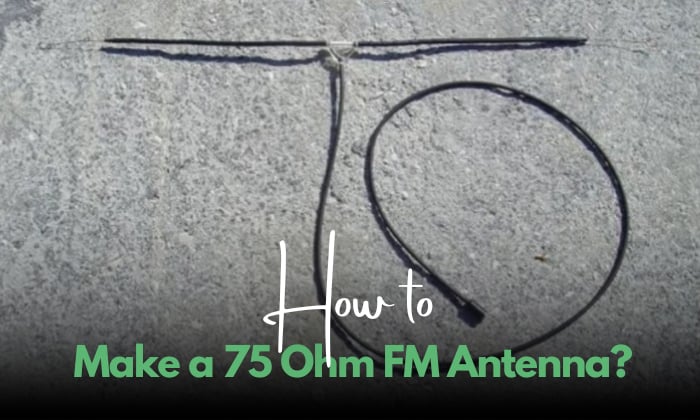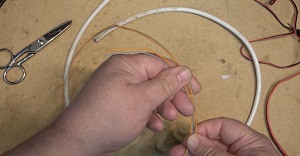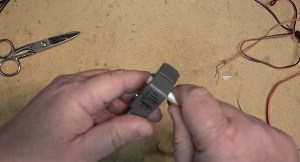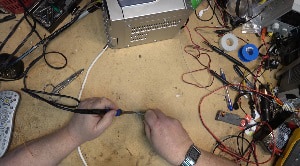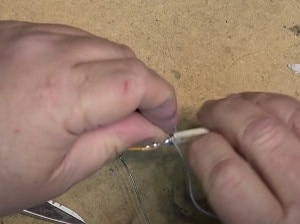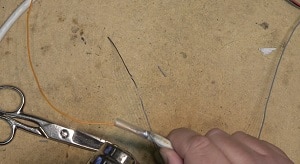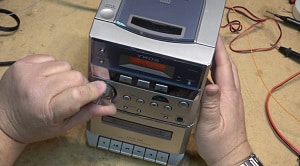As an FM radio enthusiast, you know how frustrating it is to lose signal strength and clarity when listening to your favorite FM radio station.
But don’t worry because this problem is easy to solve, especially if you already have the basic materials to operate radios. Tune in to this guide to know how to make a 75 ohm FM antenna that can be used both indoors and outdoors.
Step-by-step to Make a 75 Ohm FM Antenna
What to prepare
- Two pieces of wire
- Coaxial cable (RG-6 or RG-59)
- Connector (compatible with 75-ohm coax input)
- Cable wire stripper
- Small and big heat shrink tubes
- Heat gun (or any heat source)
- Soldering kit (iron and solder)
Step 1: Prepare the wire
To make an antenna for radio, start by cutting a piece of wire to 29.5 inches in length. This will serve as an important antenna component.
Step 2: Strip the coax cable
To prepare the coaxial cable for use as an FM antenna, use wire strippers to remove the outer insulation of the cable, about a 1/4 inch section of the insulation from the center conductor until you see the white layer underneath.
Step 3: Attach the wire
Wrap the exposed wire around the central conductor of the coaxial cable and twist them together securely. Proceed to solder the wire onto the conductor to ensure a stable connection.
Step 4: Insulate the wire
Place a small section of heat shrink tubing onto the wire section connected to the central conductor, and apply heat to the tubing to contract it, securing and protecting the wire.
Step 5: Attach the second wire
Pick up the second wire you have, and then coil it around the outer conductor of the coaxial cable. This will serve as the second element of the antenna.
Step 6: Insulate the second wire
Cover both the coaxial cable and the second wire with a bigger heat shrink tubing. You can run this bigger tubing over the first wire you put in place until it reaches the junction where your wires and cable connect.
Heat the tubing to contract it, firmly securing and insulating the twisted wires.
Step 7: Attach the connector
Connect the appropriate connector to the opposite end of the coaxial cable. This will enable you to insert the 75 ohm FM antenna homemade device into the coaxial input.
Step 8: Install the DIY high gain FM antenna
There are several installation options for the antenna, depending on your preference. You may affix it to the wall with thumbtacks or tape, or place it in an upright position in an area with strong signal reception.
Alternatively, don’t affix it at all and carry the whole thing outside whenever you want a DIY outdoor FM radio antenna. Just make sure the antenna is clear of any obstructions or interference.
There it is! By following a few straightforward steps and using basic materials, you can create an FM antenna for your 75 ohm coaxial input. Rest assured that you will be able to enhance the reception of your home stereo system.
If you’re still confused about the steps in making this DIY FM antenna, here is a YouTube video you can watch.
Frequently Asked Questions
How many ohms is an FM antenna?
FM antennas for stereo receiver may have varying impedance levels, depending on the specific combination of antenna and receiver being used. However, it is typical for them to be designed with an impedance of either 75 ohms or 300 ohms.
Most contemporary devices feature a coaxial input of 75 ohms for connecting the FM antenna, which makes the 75-ohm antenna the preferred option. Nevertheless, for older stereo receivers that come with a flat twin-lead input of 300 ohms, a 300-ohm antenna is necessary.
In this guide, it’s important to match the impedance of the DIY 75 ohm FM antenna to the input impedance of the stereo receiver to ensure optimal performance and signal quality. If the impedance of the homemade antenna for radio is incorrect, an impedance mismatch can result in signal loss and poor reception.
What is the difference between 75 ohm and 300 ohm antennas?
The topic of 75 ohm vs 300 ohm FM antenna is interesting because the difference between them is primarily related to the impedance of the antenna and the equipment that it is designed to work with.
Typically, antennas with an impedance of 75 ohms are intended for use with equipment featuring a coaxial input of 75 ohms, such as most modern FM radios and televisions.
Meanwhile, antennas with an impedance of 300 ohms are intended for use with equipment from the 50s and 70s, vintage devices, in other words.
Can I make an FM antenna from speaker wire?
Definitely, yes! To make FM antenna booster using a speaker wire, you will need to strip the insulation from the wire and then construct it into the appropriate shape for an FM antenna. In detail:
- Get a 10-feet cable.
- Separate the two strands of the cable so that the whole thing forms a T-shape. Make sure the two strands at the top are three-foot long.
- Once you’re done with the top of the cable, remove two inches of insulation at the bottom of it, then connect the stripped ends to the FM posts or clamps on the radio.
- If there’s only one post or clamp, twist the wires together before connecting to the stereo.
That’s it! Homemade FM antennas can be made with speaker cables in simple steps.
Conclusion
Building this type of antenna is an easy and affordable way to boost your FM radio signal. With just a few simple materials and basic tools, you can make FM antenna on your own to improve the clarity and, especially, quality of your overall radio experience.
So, now that you know how to make a 75 ohm FM antenna through this guide, it will be our pleasure if you share it with your friends and colleagues. Let them give it a try, so they can save some money.

Hello! I am Hart, the content writer and editor here at G0HWC. I used to be in the same local radio club with Howe, and he convinced me to join him in spreading my love for the radio with others. With a background in radio studies, I spend every day crafting accurate, easy to read content on various topics related to owning and using radios. I hope that my content can help you confidently venture in your radio journey!

